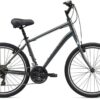Bicycles are a fantastic and healthy mode of transportation and a source of recreation, but they can take up valuable floor space in your garage. Hanging bikes on the wall is an excellent solution to maximize space while keeping your bikes organized and easily accessible. In this step-by-step guide, we’ll walk you through the process of hanging bikes in your garage, allowing you to reclaim valuable space on the floor for other storage needs.
Materials You’ll Need:
Before you start to install, gather the following materials and tools:
- Bike hooks or racks (various types are available).
- Stud finder.
- Measuring tape.
- Pencil.
- Level.
- Screwdriver or drill.
- Screws and wall anchors (if necessary).
- Safety goggles.

Step 1: Choose the Right Bike Hooks or Racks:
There are several types of bike hooks and racks available, so consider the following options to determine which one suits your needs best:
Wall-Mounted Hooks:
- Description: Wall-mounted hooks are a straightforward and cost-effective solution for bike storage. They consist of sturdy metal hooks that attach directly to your garage wall.
- Installation: To install wall-mounted hooks, locate the wall studs using a stud finder. Align the hooks with the studs and screw them securely into place. Ensure they are level for proper bike storage.
- Orientation: Bikes are typically hung vertically from these hooks. This means the bike is positioned parallel to the wall, with the front wheel up and the rear wheel down.
- Advantages: Wall-mounted hooks are space-efficient, keeping your bikes neatly organized along the wall. They are ideal for garages with enough wall space for bike storage.
Ceiling-Mounted Hoists:
- Description: Ceiling-mounted hoists are designed for garages with limited available wall space. They allow you to suspend your bikes from the ceiling, utilizing overhead space efficiently.
- Installation: Ceiling-mounted hoist systems are typically attached to ceiling joists or rafters. They consist of pulleys and hooks that can be lowered to lift and store bikes. Detailed installation instructions are provided by the manufacturer.
- Orientation: Bikes are stored horizontally when using ceiling-mounted hoists. They hang parallel to the ceiling, with the front wheel facing one side and the rear wheel on the opposite side.
- Advantages: Ceiling-mounted hoists make use of underutilized vertical space. They are particularly suitable for garages with high ceilings or limited wall space.
Floor-to-Ceiling Poles:
- Description: Floor-to-ceiling poles, also known as tension poles, are versatile and sturdy bike storage solutions. They consist of adjustable metal poles that can be extended between your garage floor and ceiling.
- Installation: Extend the tension pole between the floor and ceiling, securing it in place. Some models may come with additional hooks or arms for bike storage.
- Orientation: Bikes can be hung vertically or horizontally from these poles, depending on your preference and the design of the pole. Some models allow for multiple bikes to be stored on one pole.
- Advantages: Floor-to-ceiling poles are highly adaptable and suitable for organizing several bikes in a small garage. They provide flexibility in bike orientation.
Freestanding Bike Racks:
- Description: Freestanding bike racks are standalone structures designed to hold multiple bikes. They do not require installation on walls or ceilings, making them a convenient choice for those who prefer not to mount hooks or racks.
- Installation: No wall or ceiling installation is needed. Simply assemble the freestanding rack according to the manufacturer’s instructions and place it anywhere in your garage.
- Orientation: Bikes are typically stored vertically in freestanding racks, with each bike positioned one above the other.
- Advantages: Freestanding bike racks offer flexibility in placement and can be moved around your garage as needed. They are an excellent choice for those who want an easily removable bike storage solution.
Step 2: Find the Studs:
Using a stud finder, locate the wall studs where you plan to install the bike hooks or racks. Attaching the hooks or racks to wall studs ensures they can support the weight of your bikes securely. Mark the stud locations with a pencil.
Step 3: Measure and Mark:
Determine the height at which you want to hang your bikes. A typical height is about 4-6 feet from the ground, ensuring easy access and enough clearance for other items stored below. Use a measuring tape and level to mark the desired height on the wall.
Step 4: Install the Bike Hooks or Racks:
Follow these general steps for installing bike hooks or racks:
- For wall-mounted hooks: Align the hooks with the marked stud locations and screw them into the studs. Make sure they are level and secure.
- For ceiling-mounted hoists: Attach the hoist system according to the manufacturer’s instructions, ensuring it’s securely anchored to the ceiling joists. Use a drill and screws for a secure fit.
- For floor-to-ceiling poles: Extend the tension pole between the floor and ceiling, adjusting it to the desired height. These poles usually come with hooks or arms to hang your bikes.
- For freestanding racks: Simply assemble the rack according to the manufacturer’s instructions and place it in your preferred location in the garage.
Step 5: Hang Your Bikes:
Now that your hooks or racks are securely in place, hang your bikes by their frames. Ensure they are well-balanced and won’t tip over. Depending on the system you chose, you can hang bikes vertically or horizontally.
Step 6: Test for Stability:
Give your bikes a gentle push to ensure they are securely held in place. Double-check that all hooks, racks, or poles are properly tied/ fastened and can support the weight of your bikes.
Step 7: Safety Precautions:
- Always wear safety goggles when drilling or using tools.
- Ensure the bikes are hung at a safe height, especially if there are children around.
- Periodically check the hooks, racks, or poles for any signs of wear or loosening.

Conclusion:
Hanging bikes in your garage is an efficient way to free up valuable floor space while keeping your bicycles organized and accessible. By following this step-by-step guide and selecting the right hooks or racks for your needs, you can create a clutter-free garage that accommodates your bikes and other storage requirements. Enjoy the benefits of a well-organized garage and easy access to your beloved bicycles.
















